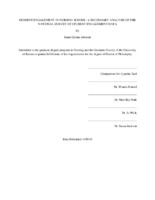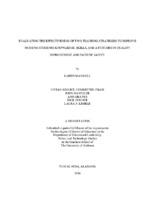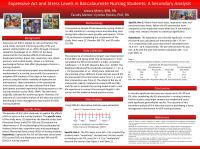| dc.contributor.advisor | Teel, Cynthia | en |
| dc.contributor.advisor | Bonnel, Wanda | en |
| dc.contributor.advisor | Park, Shin Hye | en |
| dc.contributor.advisor | Wick, Jo | en |
| dc.contributor.advisor | Jackson, Susan | en |
| dc.contributor.author | Johnson, Karen Zafuta | en |
| dc.date.accessioned | 2017-04-13T20:48:47Z | |
| dc.date.available | 2017-04-13T20:48:47Z | |
| dc.date.issued | 2017-04-13 | |
| dc.identifier.uri | http://hdl.handle.net/10755/621368 | |
| dc.description | <p>The author retains copyright.</p> | en |
| dc.description.abstract | <p>Student engagement has received considerable attention in higher education research because of the link between increased student knowledge, greater student satisfaction with educational experience, and increased student retention and persistence. The National Survey of Student Engagement (NSSE) has been used since 2000 to assess engagement in undergraduate college students. NSSE results have been used to gain an understanding about levels of academic engagement for freshman and senior college students. Institutions use NSSE results to make changes in policies and practices to improve undergraduate education.<br />This comparative descriptive study examined levels of undergraduate nursing students’ engagement during college by conducting a secondary analysis of NSSE data. The overall aim of this study was to gain a better understanding of nursing students’ levels of engagement at two points in time and comparing two geographic regions, and how they spent their time while in college. In a 2007 report, the National Leadership Council for Liberal Education and </p>
<p>America’s Promise (LEAP) identified ten innovative high-impact practices in higher education. Since then, these practices have been implemented across the nation and have been associated with gains in student learning and personal development (Kuh, 2008). This study compared senior nursing students’ levels of engagement before and after these high-impact practices were recommended to see if engagement levels in senior nursing students differed between 2003 and 2010.<br />Astin’s student involvement theory was used as a guiding framework for this study to examine how nursing students engage in the learning process and what educational resources nursing students use to become involved in the learning process. Astin’s theory focuses on what the college student does to be an active participant in the learning process and describes the environmental influences on college student development.<br />iv<br />Although statistically significant, the differences between the 2003 and 2010 nationwide cohorts of nursing students for the Level of Academic Challenge and Student-Faculty Interaction benchmarks were trivial. Senior nursing students were equally as engaged in 2010 as they were in 2003. This finding suggests consistency and stability in nursing education with regard to the Level of Academic Challenge and Student-Faculty Interaction benchmarks.<br />Senior nursing students from Kansas and Missouri were compared to senior nursing students from all other states. Senior nursing students from KS/MO were similar to students from all other states in relation to Level of Academic Challenge and Active and Collaborative Learning benchmarks and how they spent their time in a typical 7-day week. Although statistically significant, the difference between the KS/MO cohort of nursing students and cohort of nursing students from other states for the Student-Faculty Interaction benchmark was trivial.<br />In general, senior nursing students in 2010 were as engaged in their education as they were in 2003, reflecting stability in nursing education during this same time period. Senior nursing students from KS/MO were as engaged and spent their time in a similar manner as senior nursing students from all other states. This indicates that nursing students from these Midwest states have similar educational engagement as nursing students from other states and nursing education in the Midwest is consistent with the rest of the country. These findings of stability and consistency over time and across regions of the US are encouraging for nursing education. Nurse educators and higher-education administrators can build upon this strong foundation and make concerted efforts to further increase engagement in nursing students.</p> | en |
| dc.format | Text-based Document | en |
| dc.language.iso | en | en |
| dc.subject | Nursing Students | en |
| dc.subject | Student Engagement | en |
| dc.title | Student engagement in nursing school: A secondary analysis of the National Survey of Student Engagement data | en |
| dc.type | Dissertation | en |
| dc.rights.holder | <p>
All rights reserved by the author(s) and/or publisher(s) listed in this item record unless relinquished in whole or part by a rights notation or a Creative Commons License present in this item record.
</p><p>
All permission requests should be directed accordingly and not to the Sigma Repository.
</p><p>
All submitting authors or publishers have affirmed that when using material in their work where they do not own copyright, they have obtained permission of the copyright holder prior to submission and the rights holder has been acknowledged as necessary.
</p> | |
| dc.description.note | <p>This item has not gone through this repository's peer-review process, but has been accepted by the indicated university or college in partial fulfillment of the requirements for the specified degree.</p> | en |
| thesis.degree.grantor | The University of Kansas | en |
| thesis.degree.level | PhD | en |
| thesis.degree.year | 2015 | |
| dc.type.category | Full-text | en |
| dc.evidence.level | Other | en |
| dc.research.approach | Quantitative Research | en |
| dc.subject.cinahl | Students, Nursing, Baccalaureate | en |
| dc.subject.cinahl | Students, Nursing | en |
| dc.subject.cinahl | Student Attitudes | en |
| dc.subject.cinahl | Student Attitudes--Evaluation | en |
| dc.subject.cinahl | Learning Methods | en |
| dc.subject.cinahl | Secondary Analysis | en |
| dc.subject.cinahl | Surveys | en |
| dc.author.details | Karen Zafuta Johnson, PhD, RN | en |
| dc.description.reviewtype | None: Degree-based Submission | en |
| dc.description.acquisition | Proxy-submission | en |





